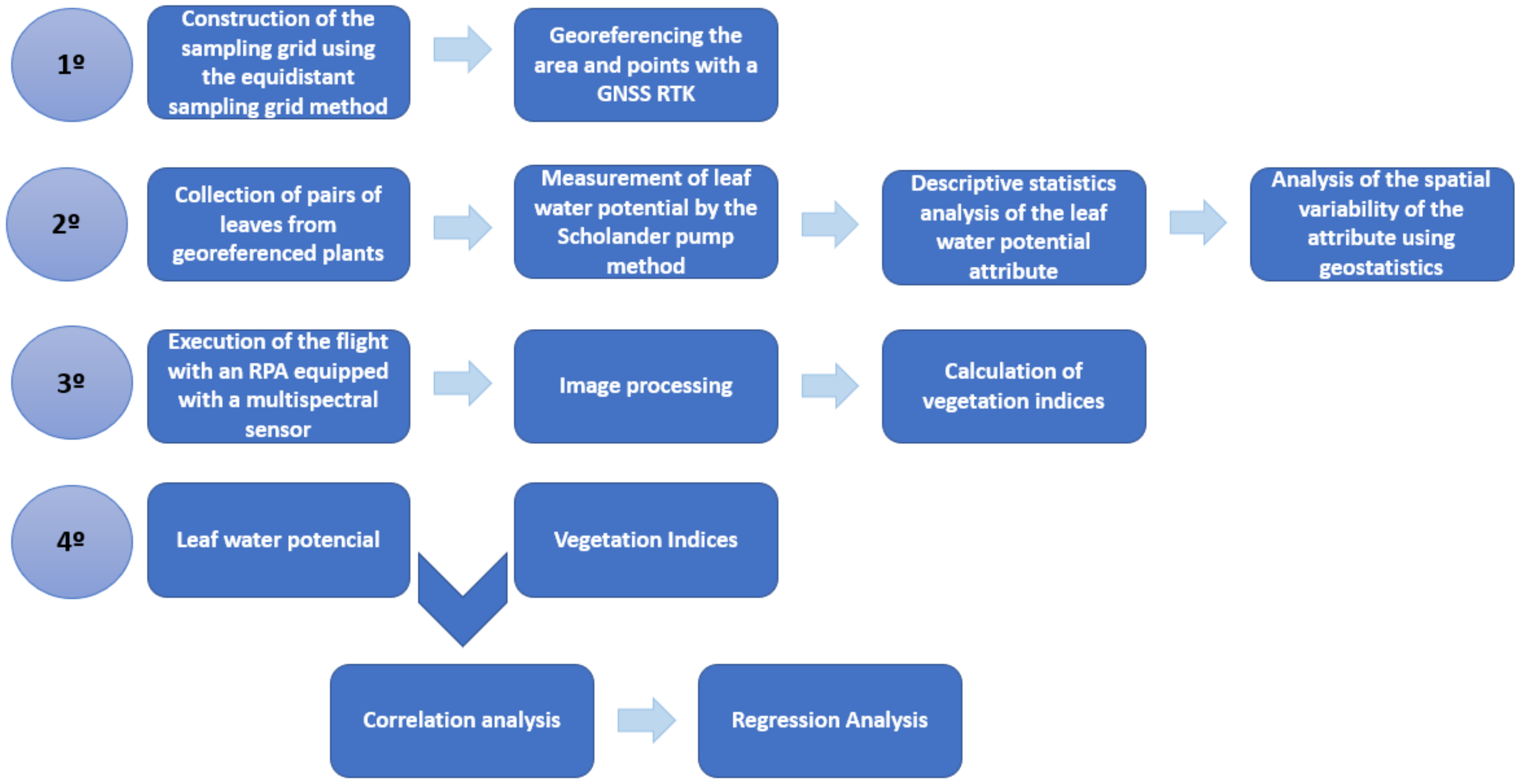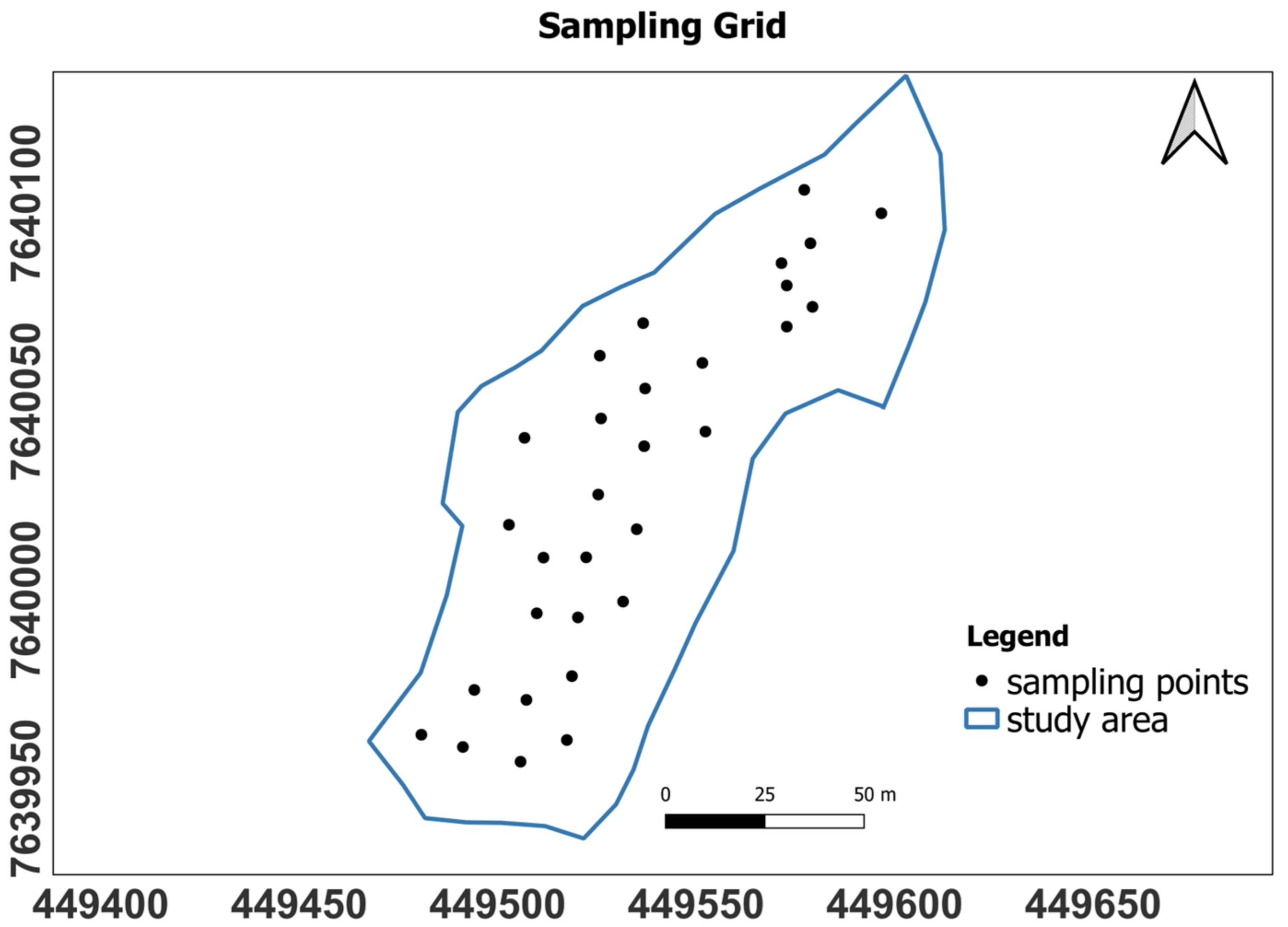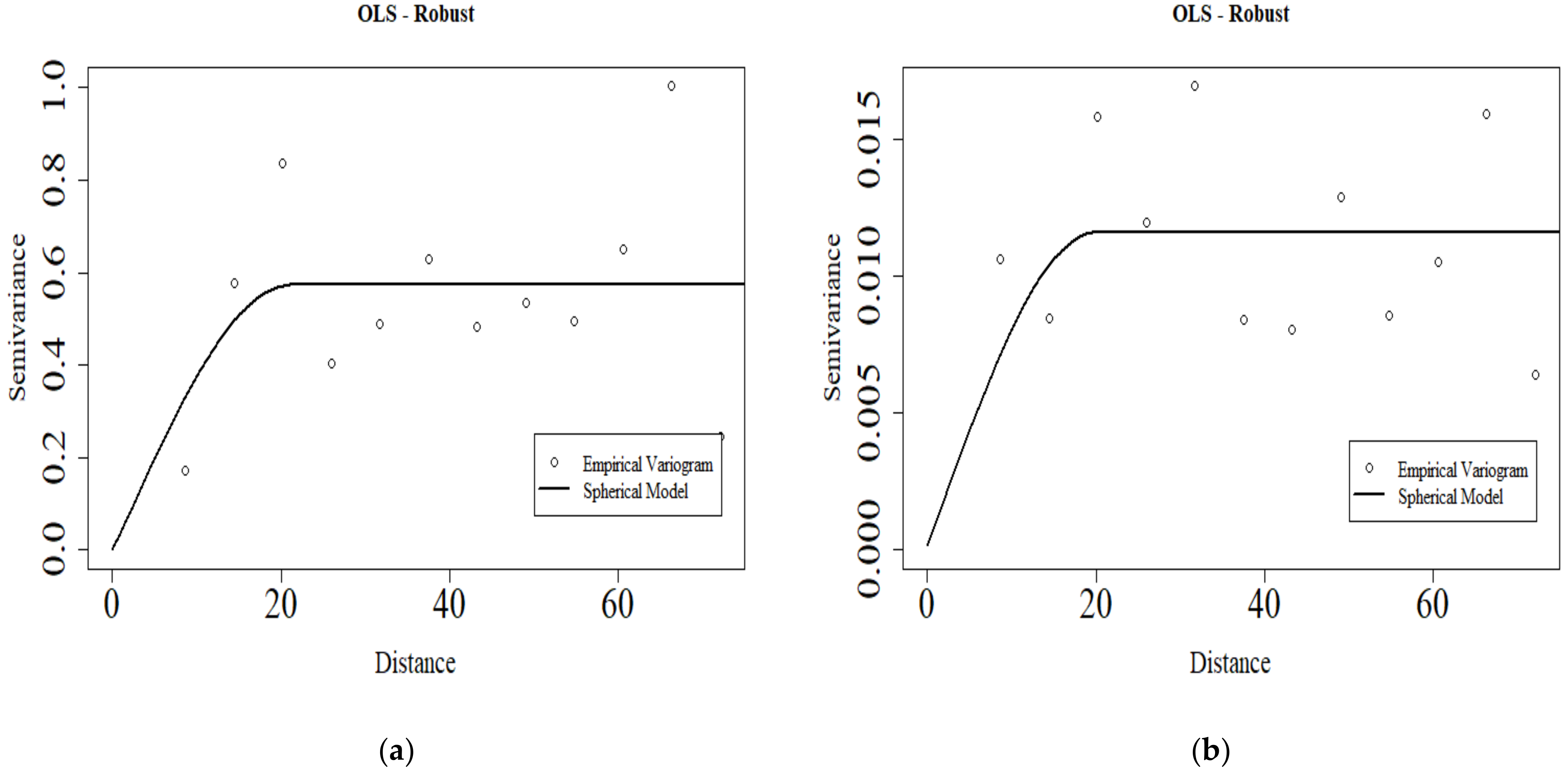Evaluation of the Water Conditions in Coffee Plantations Using RPA
Abstract
:1. Introduction
2. Materials and Methods
2.1. Workflow
2.2. Description of the Study Area
2.3. Sampling Grid
2.4. Leaf Water Potential Collection
2.5. Geostatistical Analysis
2.6. Image Acquisition and Processing
2.7. Vegetation Indices
2.8. Correlation Analysis and Linear Regression
3. Results
3.1. Hydrological Conditions
3.2. Descriptive Statistic
3.3. Geostatistical Analysis
3.4. Regression and Correlation Analysis
4. Discussion
4.1. Variation in Climatic Conditions and Descriptive Analysis of Leaf Water Potential
4.2. Geostatistical Analysis
4.3. Regression and Correlation Analysis
5. Conclusions
Author Contributions
Funding
Institutional Review Board Statement
Informed Consent Statement
Data Availability Statement
Conflicts of Interest
References
- Furlan, D.A.; De Sousa, E.F.; Mendonça, J.C.; De Souza, C.L.M.; Gottardo, R.D.; De Souza Lima, R.A. Potencial hídrico foliar e desenvolvimento vegetativo do cafeeiro conilon sob diferentes lâminas de irrigação na região e campos dos Goytacazes-RJ. IRRIGA 2021, 26, 13–28. [Google Scholar] [CrossRef]
- DaMatta, F.M.; Grandis, A.; Arenque, B.C.; Buckeridge, M.S. Impacts of climate changes on crop physiology and food quality. Food Res. Int. 2010, 43, 1814–1823. [Google Scholar] [CrossRef]
- Silva, A.S.; Lima, J.S.S. Atributos físicos do solo e sua relação espacial com a produtividade do café Arábica. Coffee Sci. 2013, 8, 395–403. [Google Scholar]
- Da Costa, G.F.; Marenco, R.A. Fotossíntese, condutância estomática e potencial hídrico foliar em árvores jovens de andiroba (Carapa guianensis). Acta Amaz. 2007, 37, 229–234. [Google Scholar] [CrossRef]
- Cavatte, P.C.; Oliveira, A.G.; Morais, L.E.; Martins, S.C.V.; Sanglard, L.M.V.P.; DaMatta, F.M. Could shading reduce the negative impacts of drought on coffee? A morphophysiological analysis. Physiol. Plant. 2011, 144, 111–122. [Google Scholar] [CrossRef]
- Ferraz, G.A.E.S.; Da Silva, F.M.; De Oliveira, M.S.; Custódio, A.A.P.; Ferraz, P.F.P. Variabilidade espacial dos atributos da planta de uma lavoura cafeeira. Rev. Ciência Agronômica 2017, 48, 81–91. [Google Scholar] [CrossRef] [Green Version]
- Carvalho, L.C.L.; Da Silva, F.M.; Ferraz, G.A.S.; Silva, F.C.; Stracieri, J. Variabilidade espacial de atributos físicos do solo e características agronômicas da cultura do café. Coffee Sci. 2013, 8, 265–275. [Google Scholar]
- Herwitz, S.; Johnson, L.; Dunagan, S.; Higgins, R.; Sullivan, D.; Zheng, J.; Lobitz, B.; Leung, J.; Gallmeyer, B.; Aoyagi, M.; et al. Imaging from an unmanned aerial vehicle: Agricultural surveillance and decision support. Comput. Electron. Agric. 2004, 44, 49–61. [Google Scholar] [CrossRef]
- Zhou, J.; Pavek, M.J.; Shelton, S.C.; Holden, Z.J.; Sankaran, S. Aerial multispectral imaging for crop hail damage assessment in potato. Comput. Electron. Agric. 2016, 127, 406–412. [Google Scholar] [CrossRef] [Green Version]
- Zhang, J.; Hu, J.; Lian, J.; Fan, Z.; Ouyang, X.; Ye, W. Seeing the forest from drones: Testing the potential of lightweight drones as a tool for long-term forest monitoring. Biol. Conserv. 2016, 198, 60–69. [Google Scholar] [CrossRef]
- Johnson, L.F.; Herwitz, S.R.; Lobitz, B.M.; Dunagan, S.E. Feasibility of Monitoring Coffee Field Ripeness with Airborne Multispectral Imagery. Appl. Eng. Agric. 2004, 20, 845–849. [Google Scholar] [CrossRef]
- Martins, R.N.; Pinto, F.D.A.D.C.; de Queiroz, D.M.; Valente, D.S.M.; Rosas, J.T.F. A Novel Vegetation Index for Coffee Ripeness Monitoring Using Aerial Imagery. Remote Sens. 2021, 13, 263. [Google Scholar] [CrossRef]
- Oliveira, H.C.; Guizilini, V.C.; Nunes, I.P.; Souza, J.R. Failure Detection in Row Crops From UAV Images Using Morphological Operators. IEEE Geosci. Remote Sens. Lett. 2018, 15, 991–995. [Google Scholar] [CrossRef]
- Santos, L.M.D.; Andrade, M.T.; Santana, L.S.; Rossi, G.; Maciel, D.T.; Barbosa, B.D.S.; Ferraz, G.A.S. Analysis of flight parameters and georeferencing of images with different control points obtained by RPA. Agron. Res. 2019, 17, 2054–2063. [Google Scholar] [CrossRef]
- Da Cunha, J.P.A.R.; Neto, M.A.S.; Hurtado, S.M.C. Estimating Vegetation Volume of Coffee Crops Using Images from Unmanned Aerial Vehicles. Eng. Agrícola 2019, 39, 41–47. [Google Scholar] [CrossRef]
- Dos Santos, L.M.; Ferraz, G.A.E.S.; Barbosa, B.D.D.S.; Diotto, A.V.; Andrade, M.T.; Conti, L.; Rossi, G. Determining the Leaf Area Index and Percentage of Area Covered by Coffee Crops Using UAV RGB Images. IEEE J. Sel. Top. Appl. Earth Obs. Remote Sens. 2020, 13, 6401–6409. [Google Scholar] [CrossRef]
- Santana, L.S.; Santos, L.M.; Maciel, D.A.; Barata, R.A.P.; Reynaldo, É.F.; Rossi, G. Vegetative Vigor of Maize Crop Obtained through Vegetation Indexes in Orbital and Aerial Sensors Images. Rev. Bras. Eng. Biossistemas 2019, 13, 195–206. [Google Scholar] [CrossRef] [Green Version]
- Dos Santos, L.M.; Ferraz, G.A.E.S.; Barbosa, B.D.D.S.; Diotto, A.V.; Maciel, D.T.; Xavier, L.A.G. Biophysical parameters of coffee crop estimated by UAV RGB images. Precis. Agric. 2020, 21, 1227–1241. [Google Scholar] [CrossRef]
- Scholander, P.F.; Bradstreet, E.D.; Hemmingsen, E.A.; Hammel, H.T. Sap pressure in vascular plants: Negative hydrostatic pressure can be measured in plants. Science 1965, 148, 339–346. [Google Scholar] [CrossRef]
- Vieira, S.R. Geoestatística em Estudos de Variabilidade Espacial do solo. Tópicos Especiais em Ciências do solo. Sociedade Brasileira de Ciência do Solo, 1st ed.; Novais, R.F., Alvarez, V.V.H., Schaefer, C.E.G.R., Eds.; Sociedade Brasileira de Ciência do Solo: Viçosa, Brazil, 2000; pp. 1–54. [Google Scholar]
- Bachmaier, M.; Backes, M. Variogram or semivariogram? Understanding the variances in a variogram. Precis. Agric. 2008, 9, 173–175. [Google Scholar] [CrossRef]
- Isaaks, E.H.; Srivastava, R.M. An Introduction to Applied Geostatistics; Oxford University Press: Oxford, UK, 1989; p. 413. [Google Scholar]
- Cambardella, C.A.; Moorman, T.B.; Novak, J.M.; Parkin, T.B.; Karlen, D.L.; Turco, R.F.; Konopka, A.E. Field-Scale Variability of Soil Properties in Central Iowa Soils. Soil Sci. Soc. Am. J. 1994, 58, 1501–1511. [Google Scholar] [CrossRef]
- Ribeiro Junior, P.J.; Diggle, P.J. GeoR a package for geostatistical analysis. R-News 2001, 1, 14–18. [Google Scholar]
- Rouse, J.; Haas, R.; Schell, J.; Deering, D. Monitoring Vegetation Systems in the Great Plains with ERTS. In Proceedings of the Earth Resources Technology Satellite Symposium, Washington, DC, USA, 10–14 December 1973; Volume 1, pp. 309–317. [Google Scholar]
- McFeeters, S.K. The use of the Normalized Difference Water Index (NDWI) in the delineation of open water features. Int. J. Remote Sens. 1996, 17, 1425–1432. [Google Scholar] [CrossRef]
- Jiang, Z.; Huete, A.R.; Didan, K.; Miura, T. Development of a two-band enhanced vegetation index without a blue band. Remote Sens. Environ. 2008, 112, 3833–3845. [Google Scholar] [CrossRef]
- Barnes, E.M.; Clarke, T.R.; Richards, S.E.; Colaizzi, P.D.; Haberland, J.; Kostrzewski, M.; Waller, P.; Choi, C.; Riley, E.; Thompson, T.; et al. Coincident detection of crop water stress, nitrogen status and canopy density using ground based multispectral data. In Proceedings of the Fifth International Conference on Precision Agriculture, Bloomington, MN, USA, 16–19 July 2000; Volume 1619, p. 6. [Google Scholar]
- Vincini, M.; Frazzi, E.; D’Alessio, P. A broad-band leaf chlorophyll vegetation index at the canopy scale. Precis. Agric. 2008, 9, 303–319. [Google Scholar] [CrossRef]
- Gitelson, A.A.; Kaufman, Y.J.; Merzlyak, M.N. Use of a green channel in remote sensing of global vegetation from EOS-MODIS. Remote Sens. Environ. 1996, 58, 289–298. [Google Scholar] [CrossRef]
- Sripada, R.P.; Heiniger, R.W.; White, J.G.; Meijer, A.D. Aerial Color Infrared Photography for Determining Early In-Season Nitrogen Requirements in Corn. Agron. J. 2006, 98, 968–977. [Google Scholar] [CrossRef]
- Chen, J.M. Evaluation of Vegetation Indices and a Modified Simple Ratio for Boreal Applications. Can. J. Remote Sens. 1996, 22, 229–242. [Google Scholar] [CrossRef]
- Crippen, R. Calculating the vegetation index faster. Remote Sens. Environ. 1990, 34, 71–73. [Google Scholar] [CrossRef]
- Huete, A.R. A soil-adjusted vegetation index (SAVI). Remote Sens. Environ. 1988, 25, 295–309. [Google Scholar] [CrossRef]
- Qi, J.; Chehbouni, A.; Huete, A.R.; Kerr, Y.H.; Sorooshian, S. A modified soil adjusted vegetation index. Remote Sens. Environ. 1994, 48, 119–126. [Google Scholar] [CrossRef]
- Rondeaux, G.; Steven, M.; Baret, F. Optimization of soil-adjusted vegetation indices. Remote Sens. Environ. 1996, 55, 95–107. [Google Scholar] [CrossRef]
- Gitelson, A.A.; Viña, A.; Ciganda, V.; Rundquist, D.C.; Arkebauer, T.J. Remote estimation of canopy chlorophyll content in crops. Geophys. Res. Lett. 2005, 32, L08403. [Google Scholar] [CrossRef]
- Santos, C.M.L.S.A. Estatística descritiva: Manual de Auto-Aprendizagem, 3rd ed.; Edições Sílabo: Lisboa, Portugal, 2018; pp. 11–20. [Google Scholar]
- Gomes, F.P.; Garcia, C.H. Estatística Aplicada a Experimentos Agronômicos e Florestais: Exposição com Exemplos e Orientações Para uso de Aplicativos; FEALQ: Piracicaba, Brazil, 2002; p. 309. [Google Scholar]
- Mota Junior, P.C.; Campos, M.C.C.; Mantovanelli, B.C.; Franciscon, U.; Cunha, J.M. Spatial variability of physical attributes of the soil in Amazonian black soil under coffee cultivation. Coffee Sci. 2017, 12, 260. [Google Scholar] [CrossRef]
- Volpato, M.M.L.; Vieira, T.G.C.; Alves, H.M.R.; Santos, W.J.R. Imagens do sensor MODIS para monitoramento agrometeorológico de áreas cafeeiras. Coffee Sci. 2013, 8, 176–182. [Google Scholar]
- Maciel, D.A.; Silva, V.A.; Alves, H.M.R.; Volpato, M.M.L.; de Barbosa, J.P.R.A.; de Souza, V.C.O.; Santos, M.O.; Silveira, H.R.D.O.; Dantas, M.F.; de Freitas, A.F.; et al. Leaf water potential of coffee estimated by landsat-8 images. PLoS ONE 2020, 15, e0230013. [Google Scholar] [CrossRef] [Green Version]
- Bacsa, C.M.; Martorillas, R.M.; Balicanta, L.P.; Tamondong, A.M. Correlation of Uav-Based Multispectral Vegetation Indices and Leaf Color Chart Observations for Nitrogen Concentration Assessment on Rice Crops. Int. Arch. Photogramm. Remote Sens. Spat. Inf. Sci. 2019, XLII-4/W19, 31–38. [Google Scholar] [CrossRef] [Green Version]
- Gago, J.; Douthe, C.; Coopman, R.; Gallego, P.; Ribas-Carbo, M.; Flexas, J.; Escalona, J.; Medrano, H. UAVs challenge to assess water stress for sustainable agriculture. Agric. Water Manag. 2015, 153, 9–19. [Google Scholar] [CrossRef]
- Nhamo, L.; Magidi, J.; Nyamugama, A.; Clulow, A.; Sibanda, M.; Chimonyo, V.; Mabhaudhi, T. Prospects of Improving Agricultural and Water Productivity through Unmanned Aerial Vehicles. Agriculture 2020, 10, 256. [Google Scholar] [CrossRef]
- Zhang, L.; Zhang, H.; Niu, Y.; Han, W. Mapping Maize Water Stress Based on UAV Multispectral Remote Sensing. Remote Sens. 2019, 11, 605. [Google Scholar] [CrossRef] [Green Version]
- Hoffmann, H.; Jensen, R.; Thomsen, A.; Nieto, H.; Rasmussen, J.; Friborg, T. Crop water stress maps for an entire growing season from visible and thermal UAV imagery. Biogeosciences 2016, 13, 6545–6563. [Google Scholar] [CrossRef] [Green Version]
- Silva, V.A.; Antunes, W.C.; Guimarães, B.L.S.; Paiva, R.M.C.; Silva, V.D.F.; Ferrão, M.A.G.; Loureiro, M.E. Physiological response of Conilon coffee clone sensitive to drought grafted onto tolerant rootstock. Pesqui. Agropecu. Bras. 2010, 45, 457–464. [Google Scholar] [CrossRef] [Green Version]
- Castanheira, D.T.; Scalco, M.S.; Fidelis, I.; Assis, G.A.; Pereira, F.S.; Matos, N.M.S. Floração e potencial hídrico foliar de cafeeiros sob regimes hídricos e densidades de plantio. Coffee Sci. 2009, 4, 126–135. [Google Scholar]
- DaMatta, F.M.; Ronchi, C.P.; Maestri, M.; Barros, R.S. Ecophysiology of coffee growth and production. Braz. J. Plant Physiol. 2007, 19, 485–510. [Google Scholar] [CrossRef] [Green Version]
- Batista, L.A.; Guimarães, R.J.; Pereira, F.J.; Carvalho, G.R.; De Castro, E.M. Anatomia foliar e potencial hídrico na tolerância de cultivares de café ao estresse hídrico. Rev. Ciência Agronômica 2010, 41, 475–481. [Google Scholar] [CrossRef]
- Silva, V.A.; Salgado, S.D.L.; Sá, L.A.; Reis, A.M.; Silveira, H.D.O.; Mendes, A.N.G.; Pereira, A.A. Use of physiological characteristics to identify genotypes of Arabic coffee tolerant to Meloidogyne paranaensis. Coffee Sci. 2015, 10, 242–250. [Google Scholar]
- Kramer, P.K.; Boyer, J.R. Water Relations of Plants and Soil; Academic Press: San Diego, CA, USA, 1995. [Google Scholar]










| Collection Period | Mean Monthly Temperature (°C) | Date of Last Rainfall | Amount of Last Rainfall (mm) |
|---|---|---|---|
| Dry (August 2020) | 19.3 | 31/05/20 | 20 mm |
| Rainy (January 2021) | 23.9 | 20/01/21 | 115 mm |
| Camera | Parrot Sequoia |
|---|---|
| Resolution of the RGB Camera | 16 megapixels |
| Resolution of the Multispectral Camera | 1.2 megapixels |
| Focal Length | 3.98 mm |
| Vertical Cover | 70% |
| Horizontal Cover | 70% |
| Spatial Resolution | 6.8 cm |
| Flight Altitude | 50 m |
| Speed | 12 m/s |
| Index | Acronym | Equation | Reference |
|---|---|---|---|
| Normalized Difference Vegetation Index | NDVI | [25] | |
| Normalized Difference Water index | NDWI | [26] | |
| Enhanced Vegetation Index 2 | EVI2 | [27] | |
| Normalized Difference Red Edge | NDRE | [28] | |
| Clorophyll Vegetation Index | CVI | [29] | |
| Green Normalized Difference Red Edge | GNDVI | [30] | |
| Canopy Chlorophyll Content Index | CCCI | [28] | |
| Green Ratio of Vegetation Index | GRVI | [31] | |
| Modified Simple Ratio | MSR | [32] | |
| Infrared Percentage Vegetation Index | IPVI | [33] | |
| Soil-Adjusted Vegetation Index | SAVI | [34] | |
| Modified Soil-Adjusted Vegetation Index 2 | MSAVI | [35] | |
| Optimized Soil-Adjusted Vegetation Index | OSAVI | [36] | |
| Green Clorophyll Index | CIgreen | [37] | |
| Red-edge Clorophyll Index | CIrededge | [37] |
| Correlation Coefficient | Correlation |
|---|---|
| Rxy = 1 | Perfect Positive |
| 0.8 ≤ Rxy < 1 | Strong Positive |
| 0.5 ≤ Rxy < 0.8 | Moderate Positive |
| 0.1 ≤ Rxy < 0.5 | Weak Positive |
| 0 ≤ Rxy < 0.1 | Very Weak Positive |
| 0 | Null |
| −0.1 ≤ Rxy < 0 | Very Weak Negative |
| −0.5 ≤ Rxy < −0.1 | Weak Negative |
| −0.8 ≤ Rxy < −0.5 | Moderate Negative |
| −1 ≤ Rxy < −0.8 | Strong Negative |
| Rxy = −1 | Perfect Negative |
| Period | Variable | Descriptive Statistics | ||||||
|---|---|---|---|---|---|---|---|---|
| Min | Max | Md | Mean | Var | SD | CV (%) | ||
| Dry | Ψw MPa (2020) | −3.3 | −0.5 | 1.15 | 1.45 | 0.61 | 0.78 | 53 |
| Rainy | Ψw MPa (2021) | −0.8 | −0.3 | 0.6 | 0.59 | 0.01 | 0.10 | 17 |
| Variable | Period | Model | C0 | C1 | C0 + C1 | A | DSD | ME |
|---|---|---|---|---|---|---|---|---|
| Ψw (MPa) | Dry | Sph | 0.10 | 0.40 | 0.50 | 20.00 | strong | 0.00 |
| Rainy | Sph | 0.01 | 15.00 | 15.01 | 0.06 | strong | 0.00 |
| Spectral Bands and Vegetation Indices | Ψw (MPa) | |
|---|---|---|
| Dry | Rainy | |
| RED | 0.3188 ns | 0.3993 ** |
| NIR | 0.0489 ns | 0.1220 ns |
| RED EDGE | 0.1921 ns | 0.0493 ns |
| GREEN | 0.2852 ns | 0.1424 ns |
| NDVI | 0.1768 ns | 0.3010 ns |
| NDWI | 0.0905 ns | 0.2620 ns |
| EVI2 | 0.0663 ns | 0.1663 ns |
| NDRE | 0.2870 ns | 0.3263 ns |
| CVI | 0.1742 ns | 0.0865 ns |
| GNDVI | 0.0905 ns | 0.2620 ns |
| CCCI | 0.2451 ns | 0.3356 ns |
| GVI | 0.1113 ns | 0.2691 ns |
| MSR | 0.1768 ns | 0.3010 ns |
| IPVI | 0.1768 ns | 0.0996 ns |
| SAVI | 0.0442 ns | 0.1710 ns |
| MSAVI | 0.1012 ns | 0.1576 ns |
| OSAVI | 0.1035 ns | 0.2090 ns |
| CI green | 0.1113 ns | 0.2691 ns |
| CI red edge | 0.2906 ns | 0.3313 ns |
| Variable | Period | Spectral Band or Index | β0 | β1 | R² |
|---|---|---|---|---|---|
| Ψw (MPa) | Rainy | RED | −0.0402 | −0.0134 | 0.1595 |
Disclaimer/Publisher’s Note: The statements, opinions and data contained in all publications are solely those of the individual author(s) and contributor(s) and not of MDPI and/or the editor(s). MDPI and/or the editor(s) disclaim responsibility for any injury to people or property resulting from any ideas, methods, instructions or products referred to in the content. |
© 2022 by the authors. Licensee MDPI, Basel, Switzerland. This article is an open access article distributed under the terms and conditions of the Creative Commons Attribution (CC BY) license (https://creativecommons.org/licenses/by/4.0/).
Share and Cite
Santos, S.A.d.; Ferraz, G.A.e.S.; Figueiredo, V.C.; Volpato, M.M.L.; Machado, M.L.; Silva, V.A. Evaluation of the Water Conditions in Coffee Plantations Using RPA. AgriEngineering 2023, 5, 65-84. https://doi.org/10.3390/agriengineering5010005
Santos SAd, Ferraz GAeS, Figueiredo VC, Volpato MML, Machado ML, Silva VA. Evaluation of the Water Conditions in Coffee Plantations Using RPA. AgriEngineering. 2023; 5(1):65-84. https://doi.org/10.3390/agriengineering5010005
Chicago/Turabian StyleSantos, Sthéfany Airane dos, Gabriel Araújo e Silva Ferraz, Vanessa Castro Figueiredo, Margarete Marin Lordelo Volpato, Marley Lamounier Machado, and Vânia Aparecida Silva. 2023. "Evaluation of the Water Conditions in Coffee Plantations Using RPA" AgriEngineering 5, no. 1: 65-84. https://doi.org/10.3390/agriengineering5010005
APA StyleSantos, S. A. d., Ferraz, G. A. e. S., Figueiredo, V. C., Volpato, M. M. L., Machado, M. L., & Silva, V. A. (2023). Evaluation of the Water Conditions in Coffee Plantations Using RPA. AgriEngineering, 5(1), 65-84. https://doi.org/10.3390/agriengineering5010005







